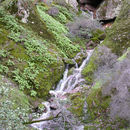Comments
provided by eFloras
Although originally considered a cytotype of Polypodium californicum , P . calirhiza is an allotetraploid involving P . californicum and P . glycyrrhiza (S. A. Whitmore and A. R. Smith 1991) and therefore should be treated as a distinct species. Some individuals of P . calirhiza can be difficult to distinguish from the two parental species (see comments under P . californicum and P . glycyrrhiza ); most collections can be identified based on a combination of blade shape, venation pattern, spore size, and geographic distribution. Polypodium calirhiza hybridizes with P . glycyrrhiza to produce sterile triploid plants with misshapen spores.
- license
- cc-by-nc-sa-3.0
- copyright
- Missouri Botanical Garden, 4344 Shaw Boulevard, St. Louis, MO, 63110 USA
Description
provided by eFloras
Stems rarely whitish to glaucous, moderately stout to slender, to 8 mm diam., acrid- or slightly sweet-tasting; scales concolored brown or slightly darker near point of attachment, lanceolate-ovate, symmetric, margins entire to erose. Leaves to 70 cm. Petiole usually slender, to 3 mm diam. Blade lanceolate-ovate to oblong, pinnatifid, widest below middle or occasionally at base, to 16 cm wide, leathery to herbaceous; rachis sparsely scaly to glabrescent abaxially, puberulent adaxially; scales lanceolate-ovate, usually more than 3 cells wide. Segments linear-lanceolate to oblong, usually less than 15 mm wide; margins conspicuously serrate; apex obtuse to acute; midrib puberulent adaxially. Venation weakly to moderately anastomosing, some to many segments lacking areoles. Sori midway between margin and midrib or slightly closer to midrib, usually less than 4 mm diam., oval when immature. Sporangiasters absent. Spores more than 58 µm, verrucose, surface projections less than 3 µm. 2 n = 148.
- license
- cc-by-nc-sa-3.0
- copyright
- Missouri Botanical Garden, 4344 Shaw Boulevard, St. Louis, MO, 63110 USA
Habitat
provided by eFloras
Sporulating winter--summer. Cliffs and rocky slopes, sometimes epiphytic; on a variety of substrates but usually on granite or other igneous rocks; 0--1500m.
- license
- cc-by-nc-sa-3.0
- copyright
- Missouri Botanical Garden, 4344 Shaw Boulevard, St. Louis, MO, 63110 USA
Synonym
provided by eFloras
Polypodium intermedium Hooker & Arnott 1840, not Colla 1836; P. vulgare Linnaeus var. intermedium (Hooker & Arnott) Fernald
- license
- cc-by-nc-sa-3.0
- copyright
- Missouri Botanical Garden, 4344 Shaw Boulevard, St. Louis, MO, 63110 USA
Distribution
provided by EOL authors
Polypodium calirhiza occurs from Oregon south to California and to the south of Mexico. Within Calidornia the species is found in northwestern California (except High North Coast Ranges), Cascade Range Foothills, Sierra Nevada (except the southern Sierra Nevada Foothills), Great Central Valley, Central Western California.

